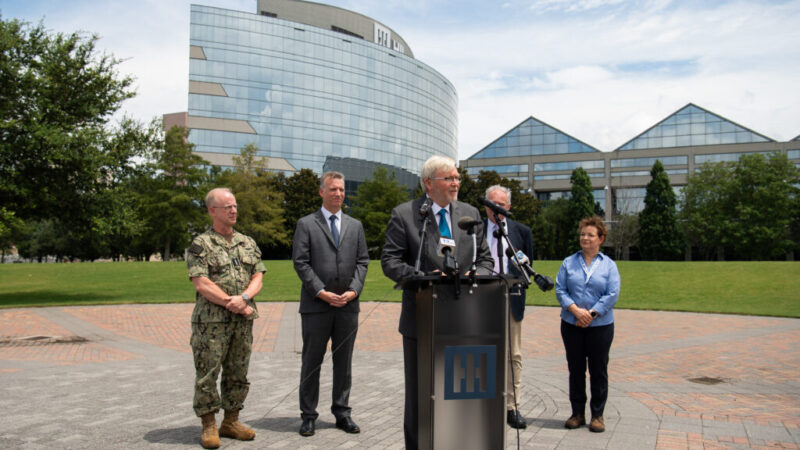A new FOI reveals Kevin Rudd has been talking the AUKUS talk, with success. Yet no amount of talk will help the US walk the AUKUS walk. Rex Patrick on the project status.
A Freedom of Information request looking into what Ambassador Kevin Rudd and his Washington staffers had been doing on AUKUS since he took up his post in March 2023 shows that he was pretty busy.
When he arrived at his Embassy post, the US Congress had already passed the Australia-United States Submarine Officer Pipeline Act. That was the first US legislative action to support AUKUS, allowing Australian submarine officers to train with the US Navy, to gain expertise in nuclear-powered submarines and to set them up to serve on their subs.
But there was a lot more work to be done. The FOI shows that AUKUS was a priority that Rudd took on with his characteristic eagerness and focus. Between March and July 2023, he met with President Biden and over 40 members of Congress of both political persuasions, with a focus on those who were members of the Armed Services Committee or Foreign Relations/Affairs Committees.
In amongst tens of private or close-knit lunches, dinners and meetings, he also spoke at a House Foreign Affairs Committee roundtable on 18 April, had drinks with twelve Republican Members of Congress on 5 July and hosted an ‘AUKUS and US-AUS International Cooperation’ dinner at the Australian Embassy with seven Senators on July 11.
By then, the Embassy was declaring victory in cables back to Australia regarding AUKUS support in Congress.

Everything’s A-OK (Source: DFAT FOI)
Transfer legislation passes
Further Embassy work saw a swath of other laws change in support of AUKUS, including laws in the 2024 National Defense Authorization Act allowing for the conditional transfer in the 2030s of three Virginia-class submarines to the Royal Australian Navy.
The conditional elements of the law are that the transfer cannot take place if it would cause a degradation of US undersea capabilities or is inconsistent with US foreign policy and national security interests. Furthermore, the law requires the President to certify the US is making sufficient submarine production and maintenance investments to meet the combination of US and Australian requirements.
And therein lies the problem.
The US Congressional Research Service (CRS) estimates that, before a transfer of submarines can occur, the US Submarine Industrial Base needs to be producing one Columbia-class nuclear missile submarine and 2.3 Virginia-class attack submarines per annum.
Currently, the Columbia submarine program, the US Navy’s highest priority program, is running between 12 and 16 months behind schedule.
Virginia-class submarines are being built at a rate of 1.2 boats per annum, way below what’s required. At the same time, the number of commissioned US submarines either in depot maintenance or idle (awaiting depot maintenance) has increased from 11 boats (21% of the attack submarine force) to 16 boats (33% of the attack submarine force).
And that is why the Albanese Government has committed $4.7B to uplift the capabilities of the US Submarine Industrial Base. The US is also injecting billions, with a plan to get to a build rate of two Virginia-class submarines by 2028.
The big picture
The problem is that, when one stands back and looks at past US performance, even with the money being spent, hitting a build rate of 2.3 Virginia-class submarines a year is fanciful.
The Government Accountability Office (GAO) testified to the House of Representatives Armed Services Seapower and Projection Forces subcommittee on March 11 this year, stating,
The Navy has no more ships today than when it released its first 30-year shipbuilding plan in 2003.
This stagnation has occurred despite regular demands and plans for a substantial increase to the Navy’s fleet size and a near doubling of its shipbuilding budget (inflation-adjusted) over the past 2 decades.”
GAO described the situation in more detail stating that; in the 2000s attack submarines took six years to build and cost around $US3B, they now take nine years to build and cost around $US4.5B (only a third of the increase can be attributed to shipbuilding inflation); destroyers used to take five years and cost $US1.9B to build and now take nine years and cost $US2.5B (the lead ship of the new Constellation class frigate program has an estimated 3 years delay, with construction stalled; aircraft carriers used to take eight years to build and now take eleven years.
Over the period 2019 to 2040 it is estimated that the US Navy will have lost 234 ship service years due to shipbuilding delays and between 2027 and 2030 the US fleet will be smaller by 20 ships, mostly attack submarines.
Both the CRS and GAO have advised Congress that it’s not just a money problem; there are systemic issues right across the board.
The CRS testified that it has taken a long time to get into this situation and that it will take a long time to “right the ship”.
Studious Ambassador Rudd and his “big careful” AUKUS shipyard cost study
Talking cross-purposes
This brings us back to an exchange in the Australian Senate between the man in charge of AUKUS, Vice Admiral Mead, and Greens Senator David Shoebridge in June last year.

(Source: Hansard)
Shoebridge was asking what happens if the US can’t deliver; will we get our $4.7B back? Mead was answering that the US was fully committed. Shoebridge was in effect asking, ‘what happens if the US can’t walk the AUKUS walk’. Mead was answering, ‘they’re talking the AUKUS talk’.
Politics over engineering?
Over the years we’ve seen Australian politicians make promises about, and commit public money to, Defence projects that have subsequently gone off the rails and cost the country dearly in terms of money spent, unavailability of military capability and the undermining of national security.
It doesn’t matter what politicians in Australia or the US say; it matters what the experienced project managers and engineers say. In addition, our Defence is, at best, very short of experienced project managers; rather, they have flag-ranked officers who’ve never run projects but need somewhere to go after successfully commanding a ship or unit.
The warning signs for AUKUS are apparent right now. Australia is an island state that needs submarines and, based on the actual states of US shipyards,
the current trajectory of AUKUS is a likely loss of our submarine force altogether.
The Government recently announced that the Collins Life of Type Extension will be scaled back, and is refusing to develop a Plan B. Plan B is no submarines, after spending $4B not buying French submarines and pouring almost $5B into the US Submarine Industrial Base.
In any normal organisation which has accountability to shareholders, someone would have been fired by now. But no-one ever gets fired in upper echelons of the Defence force.
AUKUS risks unveiled – is Australia sleepwalking into a submarines disaster?
Rex Patrick is a former Senator for South Australia and, earlier, a submariner in the armed forces. Best known as an anti-corruption and transparency crusader, Rex is also known as the "Transparency Warrior."

